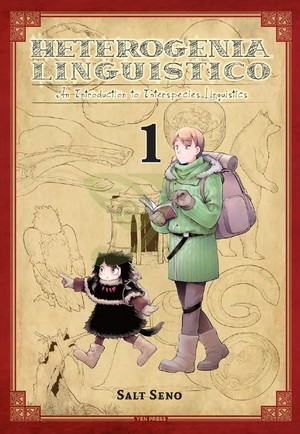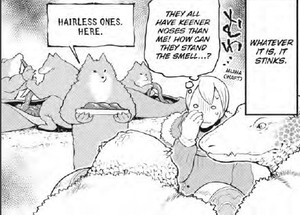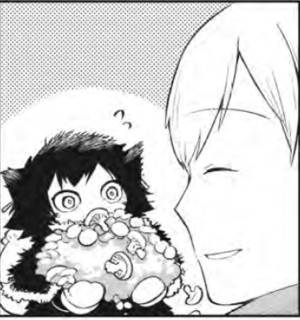The Fall 2020 Manga Guide
Heterogenia Linguistico
What's It About?
 After his professor is injured, rookie linguist Hakaba is entrusted with his work, a research trip to study the language of monsters. Travelling together with his guide Susuki, he dives into the complex world of interspecies communication.
After his professor is injured, rookie linguist Hakaba is entrusted with his work, a research trip to study the language of monsters. Travelling together with his guide Susuki, he dives into the complex world of interspecies communication.Heterogenia Linguistico is drawn and scripted by Salt Seno. The digital version of volume 1 of the manga is now available at Yen Press for $6.99
Is It Worth Reading?

Rebecca Silverman
Rating:
Heterogenia Linguistico exists somewhere between a creature manual and an anthropological text. It chronicles the journeys of a young scholar as he picks up his professor's work learning about the languages of the different creatures inhabiting an area called the Netherworld, although there's nothing to indicate that it's an actual netherworld in the afterlife sense. Instead it seems to be an area of the regular world that's inhabited by demihumans and mythological creatures of all kinds, each speaking their own relatively unique language.
As you might guess, it's clear that a lot of thought went into building the story's world. We can tell from the landscapes that humans clearly once lived in the area – the last chapters take place in the ruins of a human town and the werewolves in the first chapters have evidently taken over an abandoned human settlement – but we're not sure when it was that the demihumans replaced the humans, or even why. There don't appear to be any real feelings of distrust or hatred between the various races, although at this point the scholar is merely following his professor's notes, so everyone's interacted with a human male before, or at least seen one wandering around. That means that not only do they not want to hurt him, but they're also willing to help him out and explain anything that doesn't make sense; in fact, the werewolves provide him with Susuki, a local guide…who is also the professor's daughter with one of the werewolves. To be clear, werewolves are big bipedal wolves, not people who transform into wolves. If that's not your thing, don't think to hard about it; the story certainly doesn't.
Despite its short length, this is a fairly dense read, which is where the anthropological text aspect comes in. Details of pronunciation and how it differs between, for example, werewolves and lizardfolk is gone over in exhaustive detail, as is how each demihuman's race can affect the ways in which they communicate, like how the werewolves use scent but the lizardfolk use colors. Krakens adapt depending on who they're communicating with, while dragons become more and more unintelligible even to their own families the older they get. There's also discussion of belief systems, such as how many of the demihuman races eat their dead rather than burying them, and how hard it is for our resident human to stomach that – especially when he meets the grandkid of his lunch.
The art is fairly simple and divided into mostly smaller panels, which works with the pseudo-scholarly tone the book is taking. There aren't a lot of details – that's saved for the writing – but it is an interesting approach to writing fantasy. I'm not sure how well it will hold up across multiple volumes, but it's definitely something different if you're into D&D manuals and similar texts about the creatures we wish populated our world.

Caitlin Moore
Rating:
I am fully prepared to admit that Heterogenia Linguistico by Salt Seno is geared toward my specific niche, so take my rating with a grain of... salt. Heh.
I have a degree in linguistics, a field I love fiercely that is often poorly understood by those outside it. It's not about learning a lot of languages, but understanding the building blocks of human language. It's about sounds and structure and communication, and how other people and cultures use those blocks to build structures that are different and beautiful. It's a way of seeing and experiencing the world and it fills me with joy to see it on the page.
Not that the linguistics in Heterogenia Linguistico is exactly like anything I studied. Hakaba is conducting a field study of languages spoken by monsters like werewolves, kraken, and others in the netherworld. While all human languages have commonalities due to our shared biology, including even signed languages, monster languages and cultures are significantly different.
There is a joy in seeing your specialty represented on the page that I never realized I was missing until today. Seno clearly knows their stuff as Hakaba participates in his hosts' routines even if they seem strange and awkward, describes differences in sound systems due to anatomy, and tries his hardest to reproduce unfamiliar sounds. It's not super in-depth – he's not creating vowel charts or testing bound vs. free morphemes and listing affixes – but it rings true to the spirit of the study.
Because of my particular love of the material, it's hard for me to judge how it reads to those without training in linguistics. It's certainly driven by the application of academia to fantastical subjects, rather than story or character, but those elements still have their charm. Hakaba is out here doing his best, but he's inexperienced and easily overwhelmed. His relationships with his guides are charming, especially Susuki, the half-human, half-werewolf child. Either way, if you have any interest in language and linguistics, I can't recommend Heterogenia Linguistico strongly enough.
discuss this in the forum (29 posts) |
back to The Fall 2020 Manga Guide
Feature homepage / archives